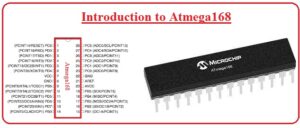 Hello, readers welcome to this engineering platform. In today’s post, we will have a detailed look at Introduction to Atmega168. It is a type of microcontroller that provides different working features and less power consuming modules. This is AVR base controller comprises of flash memory for data storage with that it has a static random access memory unit.
Hello, readers welcome to this engineering platform. In today’s post, we will have a detailed look at Introduction to Atmega168. It is a type of microcontroller that provides different working features and less power consuming modules. This is AVR base controller comprises of flash memory for data storage with that it has a static random access memory unit.In this post, we will discuss its working, features, applications, block diagram, and some other related parameters. Like other controllers this MCU also used in different types of control circuits and embedded projects. So let’s get started with Introduction to Atmega168.
Introduction to Atmega168
- The ATmega168 is AVR based eight-bit microcontroller that normally exist in three types of packaging configurations which are PDIP, MLF, and TQFP.
- The PDIP and MLF configuration comprises twenty pinouts and the third one TQFP is available in thirty-two pinouts.
- This module uses sixteen-kilo byte flash memory for storage of data and there is random access memory and electronically erasable program read-only memory with the space of one-kilo byte and five twelve bytes.
- In this module there are 3 types of communication protocol are used which are USAT, I2C, and serial peripheral interface.
- There is ten-bit analog to digital converter with eight-channel assembled on this board.
Features of Atmega168
- These are some important features of this board which is described here with the details.
- There are normally twenty-eight pinouts are created at this board and in some packaging there are thirty-two pins are exist at this board.
- It comprises of eight-bit RISC based central processing unit.
- the voltage range for which it operates is lies between 1.8 volts to 5.5 volts.
- For data storage, there is a flash memory of sixteen-kilo byte.
- With flash memory, there is random access memory of one kilobyte and EEPROM of five twelve bytes.
- For conversion of analog to digital converter, there is ten-bit with eight-channel ADC is created on the board.
- One comparator for signal comparison is used at this board.
- The signal oscillator of frequency twenty megahertz is used at this board.
- There are 3 timers are exist at this board one is sixteen-bit and the other 2 is of eight bits.
- Out of twenty-eight pins there are twenty-three pins that are used as input and output pinouts.
- It uses SPI and USART protocol for communications
- The temperature range for which it operates is lies between minus forty to plus eight five centigrade.
Pinout of ATmega168
- The main pinout of this board is described here with the details.
VCC
- At this pinout required voltage supply is provided to the board.
GND
- This pinout is used as ground.
Port B (PB7:0)
- This port comes in eight bits 2 dimension and operate as input and output port and comprises of an inner pull up resistance.
Port C (PC5:0)
- This port is seven bits two-dimension and use as input and output also consist of pull up resistance.
PC6/RESET
- This pinout is operated as input and output pinout. The electric parameters of this pinout are not alike to the other pinouts belongs to port c.
- If the RSSTDIBL fuse gets programmed then the pinout is operated as input and output pin and when get unprogrammed this pinout is operated as a reset pin.
Port D (PD7:0)
- This pinout is eight-bit two dimensional and operates as an input and output port also comprises of inner pull up resistance.
AVCC
- this pinout is used to provide voltage to the analog to digital converter. In case of the absence of the operation of analog to digital converter, this pin should be linked with the pinout VCC.
- When analog to digital converter is in operating mode than this pin must link with the VCC through the low pass filter.
AREF
- This pinout is used to provide a reference analog signals to the analog to digital converter.
Application of ATmega168
- The main application of this board is described here with the details.
- There are numerous engineering projects especially final year projects that are used on this board.
- In robots, this board is used.
- Different types of security systems and embedded systems used these controllers.
So friends that is a detailed post about ATmega168 I tried my level best to make simple this post for you. I hope you have understood this post if you have any further queries ask in the comments. thanks for reading. have a good day







